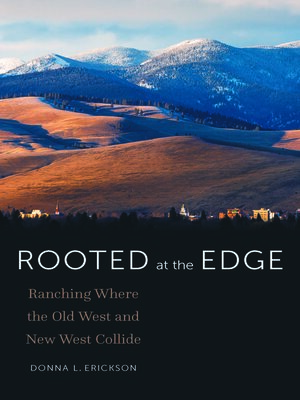
Sign up to save your library
With an OverDrive account, you can save your favorite libraries for at-a-glance information about availability. Find out more about OverDrive accounts.
Find this title in Libby, the library reading app by OverDrive.



Search for a digital library with this title
Title found at these libraries:
| Library Name | Distance |
|---|---|
| Loading... |
Rooted at the Edge paints a portrait of a ranching community in a threatened landscape steeped in history, conflict, and beauty. In this narrative nonfiction work, Donna L. Erickson explores the hilly skirt of ground at the northern boundary of Missoula, Montana, separating the town from the wilderness beyond. The North Hills region represents the critical—and often highly personal—issues at play at the edge of many western towns.
The urban-rural fringe is both valuable and vulnerable. Across the West rural lifestyles are increasingly compromised by suburbanization, economic hardship, and family dynamics; a way of life and a way of work are vanishing. Ranchland may be simultaneously cherished by a family for the life its members have made there and coveted by urban neighbors for open space. Community residents may love a place for its scenery and wildlife habitat while others wish it converted to a commercial parking lot. Complex ecological relationships can be bulldozed in a single afternoon. And the threats of climate change and shifting populations compromise the edge even more.
In the tension between love and loss, Erickson wrote this story of a landscape's soft contours, piney ridges, shady draws, and grassy slopes, and its potential disappearance under an expanding city. Rooted at the Edge conveys, in a way that statistics cannot, what's at stake when ranches at the urban fringe are threatened.
The urban-rural fringe is both valuable and vulnerable. Across the West rural lifestyles are increasingly compromised by suburbanization, economic hardship, and family dynamics; a way of life and a way of work are vanishing. Ranchland may be simultaneously cherished by a family for the life its members have made there and coveted by urban neighbors for open space. Community residents may love a place for its scenery and wildlife habitat while others wish it converted to a commercial parking lot. Complex ecological relationships can be bulldozed in a single afternoon. And the threats of climate change and shifting populations compromise the edge even more.
In the tension between love and loss, Erickson wrote this story of a landscape's soft contours, piney ridges, shady draws, and grassy slopes, and its potential disappearance under an expanding city. Rooted at the Edge conveys, in a way that statistics cannot, what's at stake when ranches at the urban fringe are threatened.







